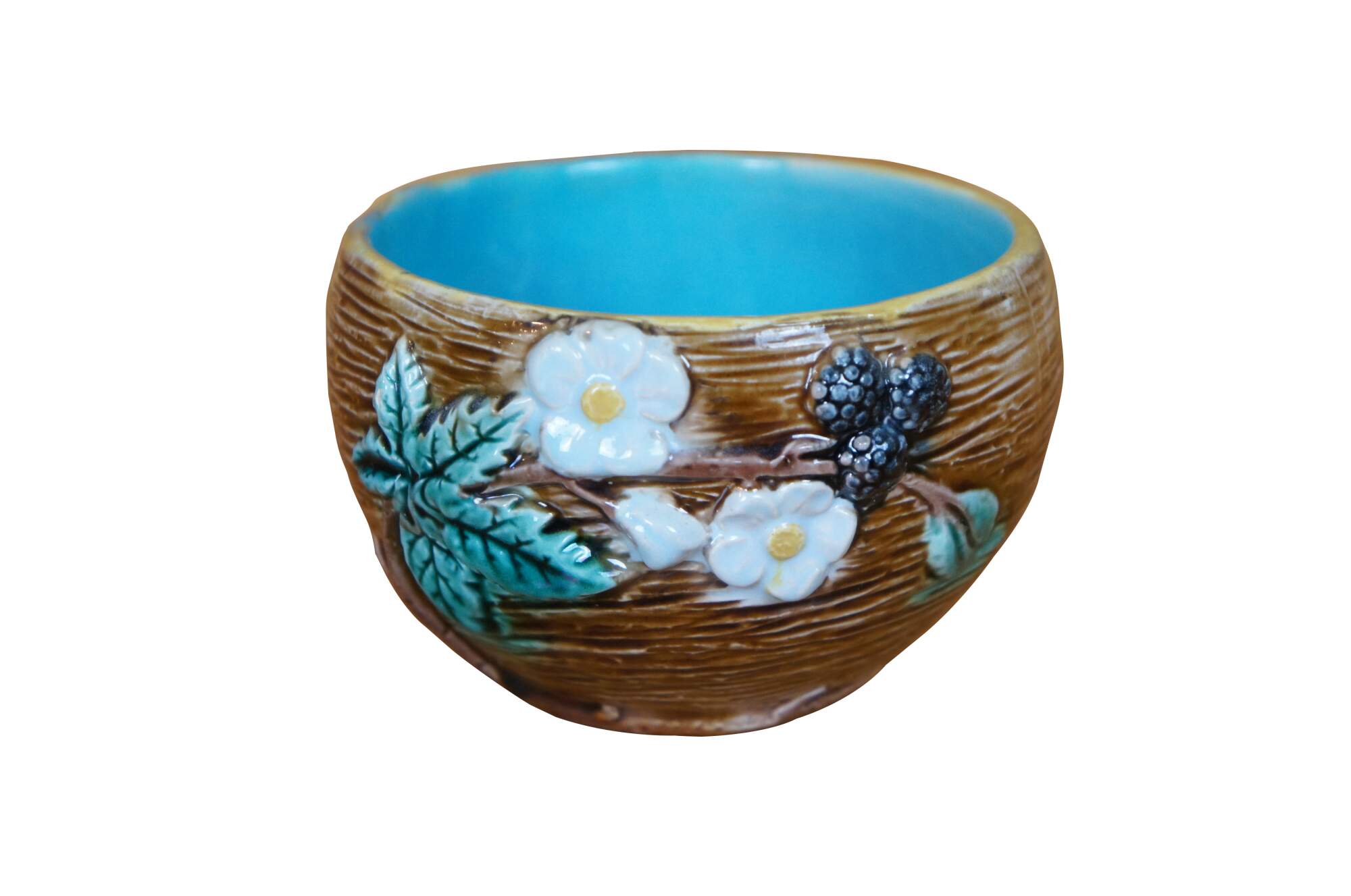
Antique Wedgwood 1877 Majolica Blackberry Fruit Sugar Bowl Compote 4"
Sold
Shipping:
Free Shipping Included
Delivery:
Estimated 2-15 Business Days
Payments:
Credit Card, Check, Cash, PayPal, Apple Pay, Venmo
Returns:
30 Days 100% Money Back Guarantee, Buyer Pays Return Shipping
Description
Antique Wedgwood Majolica fruit / sugar bowl / compote featuring a high relief blackberry and flower motif against a bark ground, turquoise interior. Circa November, 1877.
Wedgwood
The name “Wedgwood” is probably the most famous of all ceramic-producing companies, having been in existence since 1759. Josiah Wedgwood founded the pottery in Burslem and subsequently moved to Etruria in 1769.
In 1841, the firm came under the control of grandsons Josiah III and Francis, at which point the pottery was in financial peril after decades of poor management. Francis briefly partnered with John Boyle, a former associate of Herbert Minton, who raised the capital needed for the modernization of the factory. Following Boyle’s death in 1845, Francis became an equal partner with Robert Brown, a Shelton potter who injected additional capital and encouraged the development of new products. Following Brown’s death in 1859, Francis was joined in partnership by his son, Godfrey, who became Art Director and thereafter by Clement Francis Wedgwood, who became the firm’s chemist. It was at this point that the firm embarked upon the production of majolica, some ten years after the initial success of Minton. A third son, Lawrence, joined the firm in 1865. In 1987, Wedgwood merged with Waterford Crystal. The firm’s constant adaptation to the fashions of the time has allowed them to survive for two and a half centuries. It was Godfrey Wedgwood who engaged the services of prominent artists Emile Lessore, Hughes Protât, Thomas Allen, Joseph Theodore Deck, and Christopher Dresser, a central figure of the Aesthetic Movement.
It was Godfrey Wedgwood who engaged the services of prominent artists Emile Lessore, Hughes Protât, Thomas Allen, Joseph Theodore Deck, and Christopher Dresser, a central figure of the Aesthetic Movement.
Several of these artists had previously either been employed by Herbert Minton or continued to design for both firms during the years of majolica production. Interestingly, Wedgwood also received technical assistance from Leon Arnoux, Art Director at Minton. Arnoux shared expertise in the formulation and firing of majolica glazes, and his Patent Ovens were installed in the Wedgwood factory in 1875.
Upon commencing majolica production, Wedgwood drew upon its extensive historical resources and adapted for majolica a number of 18th-century neoclassical designs previously produced in creamware, black basalt, and jasperware. Mythological figures, satyrs, and tritons are common features of such pieces. These designs are meticulously documented in pattern books housed in the Wedgwood Museum. However, the vast majority of majolica output was of decorative and functional wares, leaving the production of large-scale fountains and animal figures to Minton. The peak years of majolica production in 1875-1880 saw the introduction of some 1,300 new designs.
Argenta wares were first produced in 1878 and featured a white or pale cream ground compared to the more vibrant colors of earlier Victorian majolica. The style incorporated birds, flowers, and oriental and marine motifs in keeping with the new Aesthetic Movement and was soon adopted by Simon Fielding and others. The most popular Wedgwood majolica design was the Fan pattern, composed of upright triangular oriental fans alternating with brightly colored birds and prunus blossoms. The pattern is most commonly seen in argenta, but also produced in cobalt and turquoise. Ocean, Saint Louis, Sunflower, and Lincoln were all popular designs produced in a large variety of functional table wares and conservatory items.
Despite a late start, Wedgwood’s majolica output was huge, successfully feeding the home market and exporting to the new markets of America and Australia. It is distinctive for its quality of glazes and sharpness of modeling. Most pieces bear an impressed WEDGWOOD mark in small letters. In 1860, Wedgwood also added a system of date codes, consisting of three capital letters. The first letter indicates the month, the second is a potter’s mark, and the third indicates the year of production. When present, a British registry mark notes the date of registration, and owing to the use of historical designs, may be much earlier than the actual date of production.
Condition
Good Overall - wear; crazing to base
Dimensions
4" x 2.5" (Diameter x Height)









